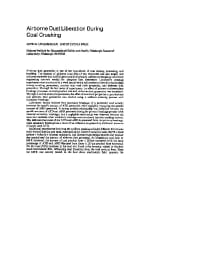Mining Publication: Airborne Dust Liberation During Coal Crushing
Original creation date: June 2001
Authors: JA Organiscak, SJ Page
Airborne dust generation is one of the byproducts of coal mining, processing, and handling. The amount of airborne total dust (ATD, respirable size and larger) and airborne respirable dust (ARD) generated is of primary interest for designing the level of engineering controls needed for adequate dust abatement. Laboratory crushing experiments were conducted in a wind tunnel with a roll crusher to identify relationships among crushing parameters, product size, coal rank properties, and airborne dust generation. Through the first series of experiments, the effect of primary and secondary breakage processes on both product size and airborne dust generation was examined. Through a second series of experiments, the effect of coal rank properties on product size and airborne dust generation was studied using a uniform crushing process with secondary breakage. Laboratory results indicate that secondary breakage of a particular coal notably increases the specific amount of ATD generated, while negligibly impacting the specific amounts of ARD generated. A strong positive relationship was identified between the specific amounts of ATD and ARD generated during the primary breakage process (with minimal secondary breakage), but a negligible relationship was observed between the same two variables when secondary breakage was introduced into the crushing process. This indicates that most of the ATD and ARD is generated from the primary breakage, while secondary breakage has more of an influence on generating additional amounts of larger sized ATD.

- Benchmarking Longwall Dust Control Technology and Practices
- Coal Dust Explosibility Meter Evaluation and Recommendations for Application
- Coal-Dust Explosion Tests in the Experimental Mine 1919 to 1924, Inclusive
- Determining the Spatial Variability of Personal Sampler Inlet Locations
- Differential Pressure Response of 25-mm-Diameter Glass Fiber Filters Challenged with Coal and Limestone Dust Mixtures
- Evaluation of LIDAR as a Novel Remote Dust Sensing Technology
- Evaluation of the Bagged Stone Dust Barrier Effectiveness in a Bord and Pillar Mine
- Rock Dusting Considerations in Underground Coal Mines
- Status of a Tapered Element, Oscillation Microbalance-Based Continuous Respirable Coal Mine Dust Monitor
- Technology News 515 - Float Coal Dust Explosion Hazards